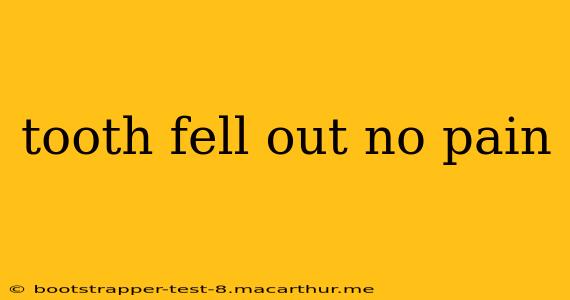Losing a tooth can be alarming, especially when it happens without any pain. While a painless tooth loss might seem less serious than a painful extraction, it's crucial to understand the potential causes and take appropriate action. This comprehensive guide will explore the reasons behind painless tooth loss, address common concerns, and advise on the necessary steps to take.
Why Did My Tooth Fall Out Without Pain?
The absence of pain during tooth loss often points towards underlying issues that have weakened the tooth's structure over time. Several factors can contribute to this:
-
Gum Disease (Periodontal Disease): Advanced gum disease, or periodontitis, is a major culprit. Infection and inflammation destroy the supporting structures of the tooth (the gums and bone), leading to loosening and eventual loss without significant pain. This is because the nerve within the tooth may have already been damaged or died due to the infection.
-
Tooth Decay (Cavities): Extensive tooth decay can weaken the tooth's structure to the point of fracture or spontaneous shedding. While cavities often cause pain initially, severe decay can lead to nerve damage, resulting in painless tooth loss in the later stages.
-
Trauma: While often associated with pain, minor trauma to the tooth or jaw can sometimes cause a tooth to loosen and fall out later without immediate pain. The damage might not be immediately apparent, and the tooth might appear healthy until it unexpectedly falls out.
-
Loose Tooth (Normal Exfoliation): In children, losing baby teeth is a natural process. This usually happens without pain as the roots of the baby teeth dissolve, allowing the tooth to fall out easily. However, it's important to distinguish this from adult tooth loss.
What Should I Do If a Tooth Falls Out Painlessly?
The most important step is to see a dentist immediately. While the lack of pain might seem reassuring, the underlying cause needs professional assessment and treatment. Delaying treatment can lead to further complications, such as:
-
Infection: The empty socket can become infected, causing pain, swelling, and potentially more serious health problems.
-
Bone Loss: The jawbone continues to resorb (lose density) in the absence of a tooth, potentially affecting adjacent teeth and the overall structure of your jaw.
-
Further Tooth Loss: If the underlying cause isn't addressed, you may lose more teeth.
-
Difficulty Chewing and Speaking: A missing tooth can impact your ability to eat and speak comfortably.
What Happens After a Tooth Falls Out? Will It Grow Back?
Unfortunately, adult teeth do not grow back naturally. Your dentist will assess your situation and discuss the best replacement options, which might include:
-
Dental Implants: These are artificial tooth roots surgically placed into the jawbone, providing a stable base for a crown.
-
Dental Bridge: A bridge replaces the missing tooth with an artificial tooth that is anchored to adjacent teeth.
-
Partial or Full Dentures: Removable dentures can replace missing teeth, either partially or fully.
Is it Normal for a Tooth to Fall Out Without Any Pain?
While the absence of pain during tooth loss might seem unusual, it's not necessarily uncommon, particularly with underlying conditions like advanced gum disease. However, it's essential to consult a dentist to determine the exact cause and prevent further problems. Painless tooth loss should never be ignored.
How Can I Prevent Tooth Loss?
Practicing good oral hygiene is crucial:
- Brush your teeth twice a day: Use fluoride toothpaste and a soft-bristled toothbrush.
- Floss daily: Removes plaque and food particles from between teeth.
- See your dentist regularly: For checkups and professional cleanings.
- Maintain a healthy diet: Limit sugary and acidic foods and drinks.
By taking proactive steps to maintain your oral health, you can significantly reduce the risk of painless tooth loss and other dental problems.
This information is for general knowledge and does not constitute medical advice. Always consult a qualified dental professional for diagnosis and treatment.
